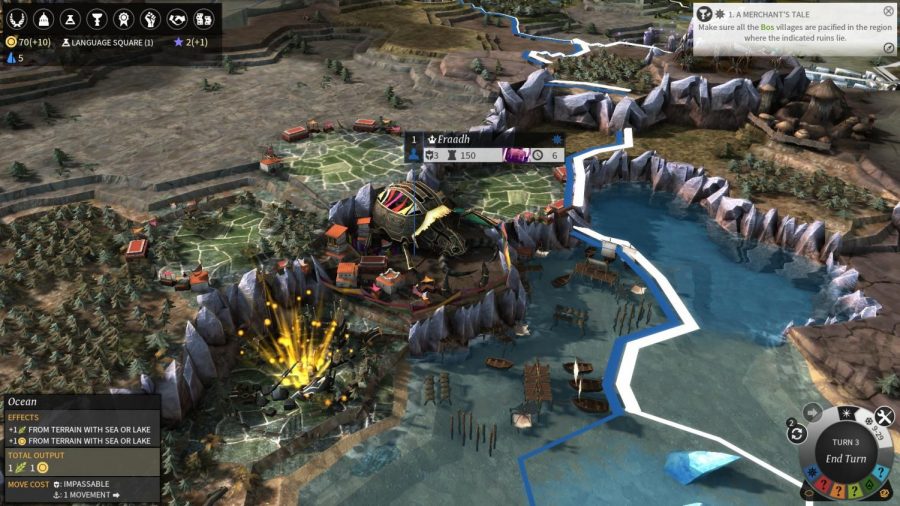Build an Empire, Face a Climate Crisis in Endless Legend
With the recent announcement of Amplitude’s so-called magnum opus Humankind, which appears to be a spiritual successor to Endless Legend, it seems appropriate to visit this game of exploration, expansion, exploitation and extermination.
Endless Legend presents a vibrant range of colors, with imaginative fantastical creatures.
In this brand new column, I will be reviewing niche and lesser-known games.
Endless Legend by Amplitude Studios is a 4X game released in 2014.
This imaginative strategy title inspired by Sid Meier’s Civilization challenges the player to build an empire on the lost planet of Auriga.
As a player, you assume the role of a powerful monarch tasked with leading your people to a bright future as the planet slowly succumbs to a freezing climate crisis.
With the recent announcement of Amplitude’s so-called magnum opus Humankind, which appears to be a spiritual successor to Endless Legend, it seems appropriate to visit this game of exploration, expansion, exploitation and extermination.
Players will immediately notice the game’s glamorous art style. Graphically speaking, Endless Legend isn’t very impressive, but it presents itself with a vibrant range of colors, with imaginative fantastical creatures, not to mention the unique design attributed to each faction, which I will get into later.
Additionally, just about every technology, building and quest in this game has a beautifully-painted image attributed to it. These act as a window into the game world, a breath of fresh air from the constant view of the hexagonal map.
While we’re still on the topic of the game’s cosmetic presentation, the soundtrack of Endless Legend is absolutely phenomenal, sporting flutes, choirs and what I believe to be cello. As music is hard to describe, you can sample the music on YouTube.
The game is composed of hexagonal tiles on which stand the cities, plains, valleys and forests that make up the game. That is where the differences with the aforementioned Civilization end. At the core of Endless Legend are five resources: food, industry, dust, science, and influence.
Food and industry are consumed by the same city that produces them; they cannot be “exported”. They are used to maintain/grow populations and build infrastructure, respectively. Science, dust and influence are available empire-wide.
As one might expect, science is used to research new technology, while dust is the game world’s common currency. Influence is also a currency, but is spent on diplomatic actions such as peace treaties, war declarations and the like. Alternatively, you could save your influence for the “Empire Plan”, an event that occurs every eighteen turns, in which you institute policies that provide empire-wide benefits.
Each hexagonal tile contains some combination of these resources. A city’s productivity per turn is determined by the resources that exist in the surrounding tiles. Resource production can be boosted by assigning workers; each unit of the population in your city provides a worker that is represented in the user interface, and these workers can be reassigned to enhance output.
For example, workers in the food column will boost food production by X amount per worker. Cities can be expanded with each additional two population units, extending the reach of the city to access more tiles and resources.
Another thing that makes this game stand out is the winter. It comes every ten turns or more, and the game gives only a rough estimate of when it will arrive. During the winter, resources are scarce, vision is limited, and troop movement is reduced by a quarter. As the game goes on, winters become longer and harsher.
The winter shakes up strategies, giving war plans a window of limited opportunity and forces players to stock up on resources. This effectively urges players to achieve victory before the length of summers shrink, ushering in an eternal winter.
Every empire needs a means of defending itself, and of course Endless Legend has systems to simulate warfare. While the rest of the game’s mechanics are good, combat feels long, drawn out and rather unimpactful. In manual combat, the competing armies, which will usually be stacked onto one tile, will unpack onto a roughly 10×10 hex area.
The player issues orders to each of their units, such as attack and move, then watches it happen. These units will go in an order determined by their initiative stat, resulting in a series of soldiers advancing, retreating, and repositioning one after another. The reason this system is so tiresome is because even though you get to choose what your troops do, the success or failure of their attacks relies too greatly on randomness.
You can win Endless Legend in several different ways, such as making the most profit, completing the victory quest, building a temple at the center of the planet, having the most diplomatic ties for longest, having the most territory, developing the best technology, being the last empire standing, capturing all capital cities or simply having the best overall score by the turn limit.
In my opinion, however, the best part of Endless Legend is not in its mechanics, but how they are subverted by the diverse roster of factions. Some factions are a bit more tame, which is good for new players. Others, however, will force you to take a completely different approach to how you play.
The Cultists, for example, only get one city. They expand by converting villages that dot the countryside. The Broken Lords have the same capabilities as any other faction, save for the fact that they do not subsist on food, only dust.
If you feel yourself more of a warmonger, you can overpower empires as Necrophages with swarms of hungry bugs. And that’s just three of the eight factions of the base game, with more added in expansions.
And that is not even all the features, as Endless Legend has more complex systems that I did not get to touch on, such as strategics, luxuries, heroes, quests and tribal diplomacy.
Overall, it’s one of the best strategy games out there, and I’m excited to see Amplitude Studios implement the lessons they learned from developing it into Humankind. I give Endless Legend a 95/100.

Joey began writing for the Beachcomber in 2017. He covers movie and game reviews. In addition to writing for the Beachcomber, he plays video games.










